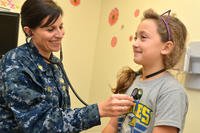Airborne Ranger combat veteran Spencer Coursen has built his business, Coursen Security Group, as a premier threat management consultant to world leaders, celebrities, Fortune 500 titans, and organizations including schools. Coursen has an exceptional record of success in the evaluation and resolution of threats, conflict resolution, protective operations, employee terminations, physical security assessments, policy authorship, and vulnerability reduction. Here are his tips for parents in light of the recent tragedy in Florida.
Today’s parents are no longer satisfied with being told that “everything is being done” to keep their children safe at school. And in light of the recent school shooting tragedy in Florida, parents and students are wondering just how they can stay safe.
Related article:
3 PERSEC Tips From an Airborne Ranger
Top five school safety questions every parent should have answered:
1. When was the last safety and security assessment conducted? Who conducted it? What were the findings? What enhancements were recommended? What actions were taken? When is the next assessment scheduled?
Safety requirements are mandated at the state level, but individual school boards still have a lot of discretion in how those directives get implemented at the local level. Virginia, for example, requires schools to have a security audit conducted every year, but not all states adhere to these same standards. Furthermore, not all states place the same emphasis on the safety of their students. Some schools choose to have their audits focus on property-related concerns like computer theft and vandalism rather than student safety.
2. Who is the administrator responsible for handling the school’s threat assessment and management program?
The goal of a threat assessment and management program is to provide students who self-identify their despair with the help they need by managing their harmful ideation toward peaceful resolution.
Ask about the reporting of concerns at your child's school. Ask what you can do to help. Remember: Everyday safety requires the participation of everyone.
3. What is the school’s access control policy for visitors and student re-admittance once classes are in session? How is this policy enforced?
In most cases, schools have a very well-written policy for granting entry into the school once classes are in session. Regrettably, those who are responsible for allowing access are often inundated with other responsibilities which may lead to a lack of consistency in how the policy is practiced. For example, the gate-keepers may confirm the legitimacy of a visiting parent, but may miss the ill-intended intruder "tailgating" behind them. One of the biggest risks facing many schools is the wide divide between policy and practice -- between what they say is being done, and what is actually being accomplished.
4. What are the determining factors for when to evacuate and when to shelter-in-place? Who is the decision maker?
The difference between when to evacuate and when to shelter in place is pretty cut and dry. As general rule, if the threat is external to the school (high winds, falling trees, severe storms) you stay inside and shelter-in-place where it is safe. Conversely, if the threat is internal to the school, (fire, gas leak, active shooter) the best practice is to evacuate in order to put as much time and distance from the threat as possible.
5. What nearby safe-havens are in close proximity (running distance) to the school where your child could go in the event of an emergency evacuation?
"Safe Havens" are places which offer safety, support, and protection. Restaurants are great. They have food, water, bathrooms, and landlines for making phone calls. When in doubt: Run to a restaurant. (Hint: Restaurants are great for family reunification too.)
Most schools are designed as a series of interconnected and compartmentalized areas that offer their own pockets of protection in the form of dispersion and separation. Evacuation locations negate this protection by having everyone move from their respectively disjointed areas to a single, pre-designated position. If someone really wanted to do the most harm, the evacuation point would offer the most “bang for the buck” because almost all evacuation points are outside of the secure perimeter and are easily researched on social media.
At the end of the day, children deserve a safe and welcoming learning environment.
Administrators seeking to improve student safety need to remember one thing: Unlike algebra, safety has evolved into a completely different subject matter from what many administrators once learned.
Be an informed parent by asking the right questions. This will help empower you to ensure your child's safety.
Spencer Coursen, Airborne Ranger veteran and founder of Coursen Security, is a nationally recognized threat management expert who has an exceptional record of success in the assessment, management, and resolution of threats, domestic and global security operations, investigations, policy authorship, and protective strategy. Follow him on Twitter at @spencercoursen
-- Sean Mclain Brown can be reached at sean.brown@military.com. Follow him on Twitter at @seanmclainbrown.















